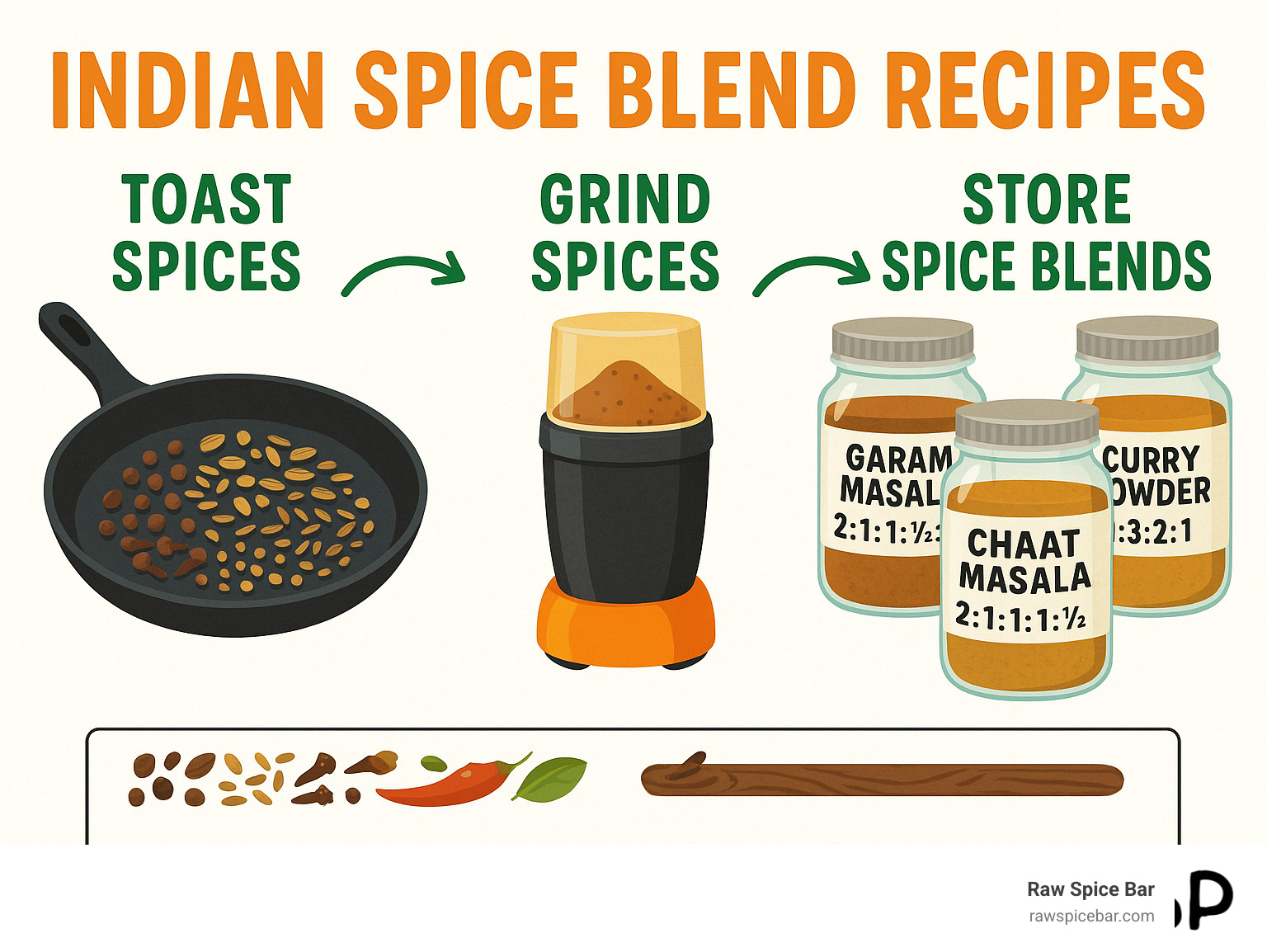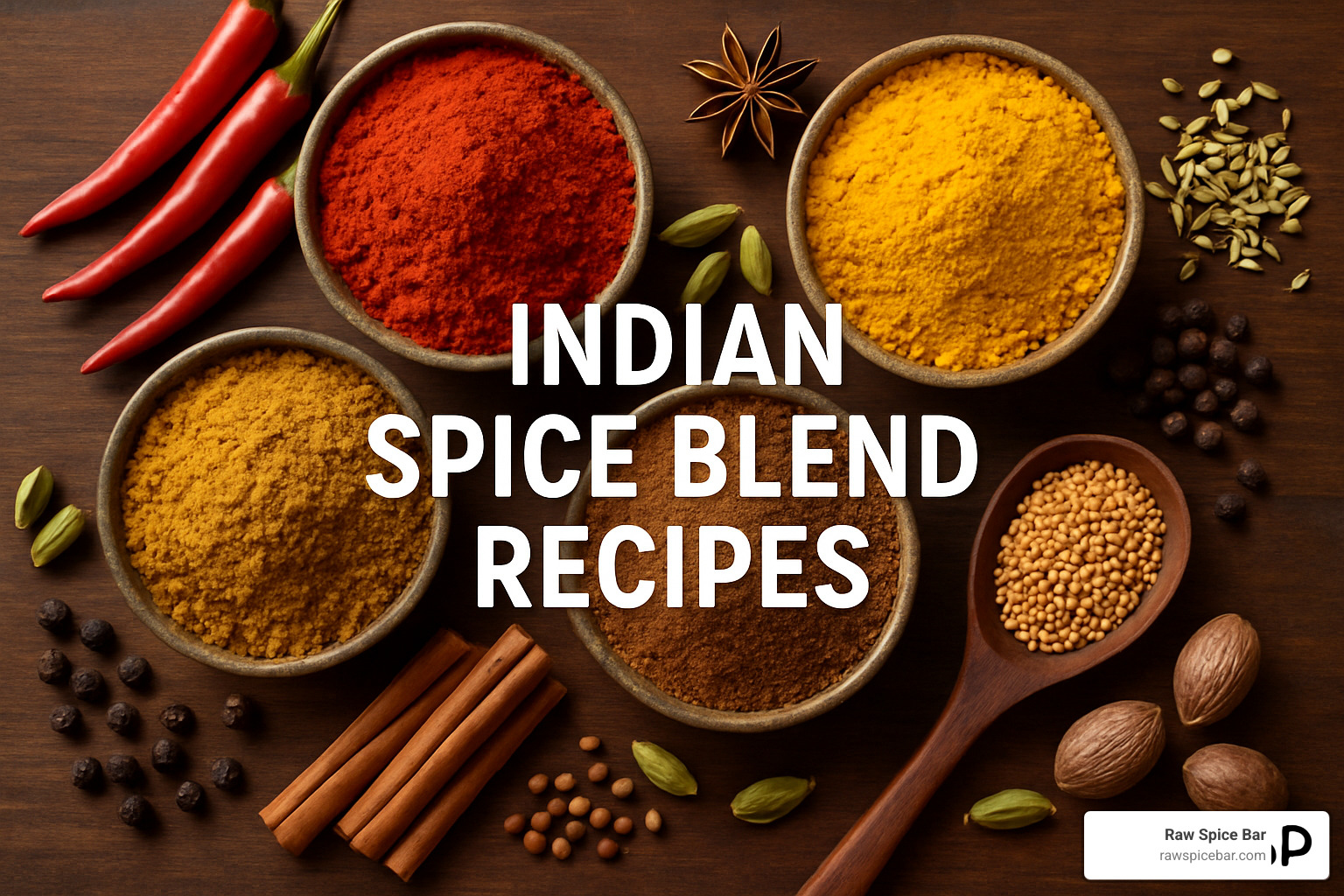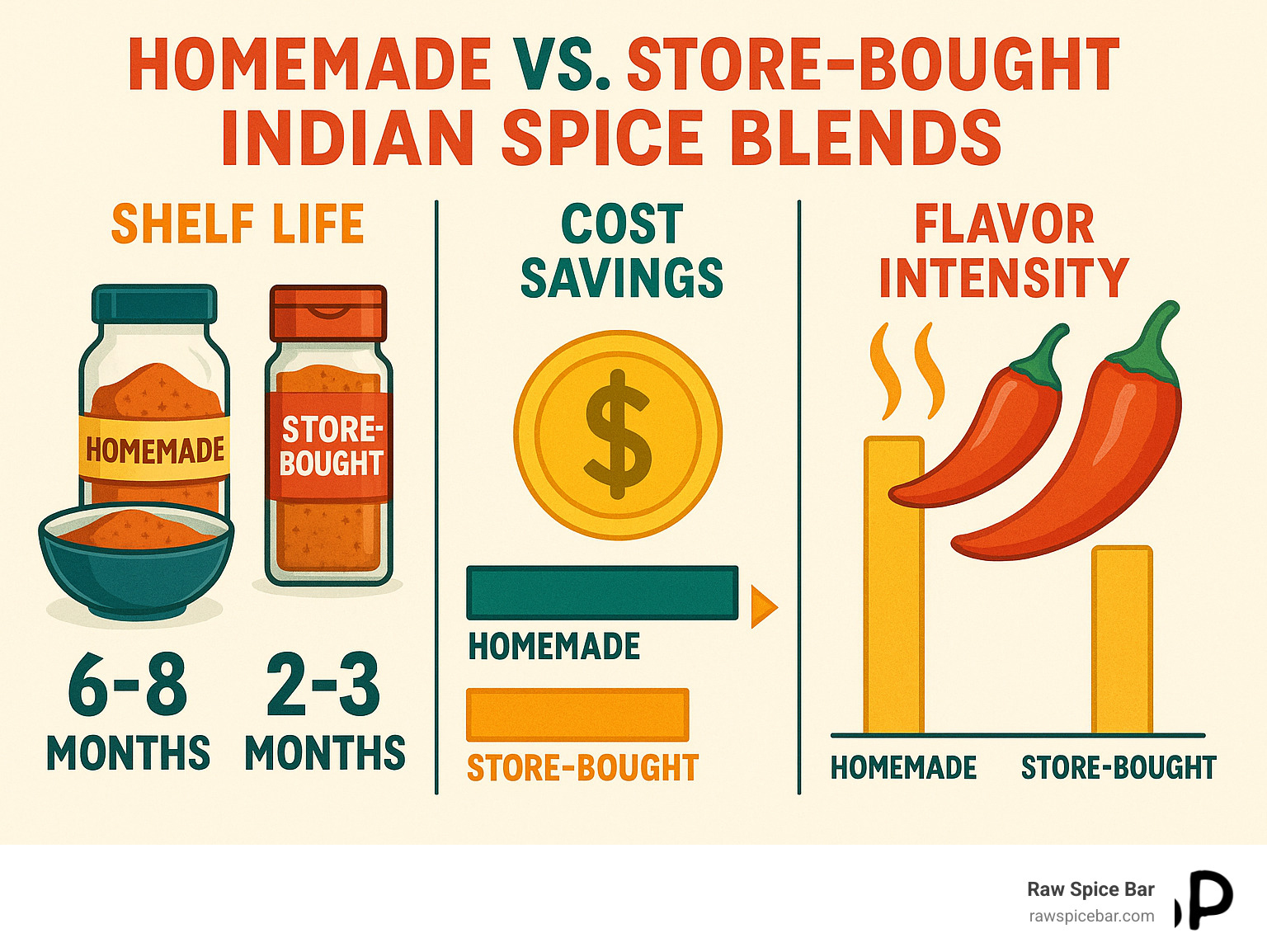Why Indian Spice Blends Transform Your Kitchen Into a Flavor Paradise
Indian spice blend recipes open up the secret to restaurant-quality curries, aromatic rice dishes, and vibrant vegetarian meals right from your home kitchen. These carefully balanced mixtures of roasted and ground spices have been perfected over centuries across different regions of India.
Essential Indian Spice Blends You Need:
- Garam Masala - Warming blend for finishing curries and rice
- Tandoori Masala - Smoky mix perfect for grilled meats and vegetables
- Chaat Masala - Tangy sprinkle for salads and street food
- Curry Powder - All-purpose base for quick weeknight meals
- Panch Phoran - Five-seed Bengali tempering blend
- Sambar Powder - South Indian lentil stew essential
The beauty of making your own blends lies in freshness and control. Store-bought versions often lose their punch after months on shelves, while homemade masalas burst with aromatic oils from freshly toasted spices. A typical homemade blend contains only 13 calories per 2 tablespoons, making it a flavorful yet healthy way to transform simple ingredients into extraordinary meals.
Mastering Indian spice blend recipes is the fastest path to confident Indian cooking. The right combination of fresh, properly roasted spices can turn a basic dal or vegetable curry into something truly special.

Basic Indian spice blend recipes terms:
What Are Indian Spice Blends & Why Make Them?
Step into any Mumbai kitchen during dinner prep, and you'll hear the rhythmic sound of spices being ground fresh. This daily ritual connects modern home cooks to thousands of years of culinary wisdom. Indian spice blend recipes aren't just cooking shortcuts - they're edible stories passed down through generations.
The word "masala" literally means "spice mixture" in Hindi, but represents so much more. These carefully balanced blends reflect the soul of different Indian regions, each shaped by local ingredients, climate, and family traditions.
Indian spice blending connects deeply to Ayurvedic principles. Ancient healers categorized spices by their warming or cooling properties, believing certain combinations could balance the body's energy. Garam masala translates to "warm spice mix," not because it burns your tongue, but because these spices were thought to generate internal warmth.
Here's where the curry powder myth needs clearing up. This yellow-tinted blend was actually invented by British traders in the 18th century who wanted to recreate Indian flavors back home. Real Indian cooking relies on specific masalas crafted for individual dishes.
Making your own blends transforms your cooking beyond flavor. Freshness makes the biggest difference - whole spices hold onto their essential oils for up to a year, while pre-ground versions lose their punch within months. When you toast and grind your own spices, you're capturing those aromatic oils at their peak.
The cost-saving benefits add up quickly. A homemade garam masala costs about 60% less than premium store versions, and you know exactly what's in every batch. No mystery anti-caking agents or fillers.
But perhaps the best reason is customization. Indian regional diversity means what tastes perfect in Punjab might seem bland in spice-loving Rajasthan. When you control the blend, you can dial up the heat, leave out allergens, or create salt-free versions.
This flavor layering approach - building complex tastes through thoughtful spice combinations - separates good Indian food from truly memorable meals.
More info about Essential Spices
Difference Between Curry Powder & Garam Masala
The confusion between curry powder and garam masala trips up even experienced home cooks, but understanding their differences is key to authentic Indian flavors.
Curry powder's history tells the story of British colonial influence. Traders wanted to bring "Indian" flavors back to England, so they created this all-in-one yellow blend dominated by turmeric.
Garam masala represents authentic North Indian tradition. This aromatic blend focuses on warming spices like cardamom, cinnamon, cloves, cumin, coriander, and black pepper. Notice what's missing? No turmeric.
The usage differences matter just as much. Curry powder gets stirred in early to build flavor foundation, while garam masala acts as a finishing spice. You sprinkle it over completed dishes or stir it in during final minutes to preserve those delicate aromatics.
More info about Garam Masala vs Curry Powder
10 Must-Try Indian Spice Blend Recipes
Ready to transform your kitchen into a fragrant spice paradise? These Indian spice blend recipes will give you the foundation for authentic curries, aromatic rice dishes, and vibrant vegetarian meals that rival your favorite restaurant.
The magic happens when you understand simple techniques. Dry roasting whole spices in a pan for 2-3 minutes releases precious essential oils. Let everything cool completely before grinding - this prevents moisture buildup that can turn your blend clumpy.
Keep batches small. These homemade blends stay fresh for 6-12 months, but fresh spices taste better. Most blends contain only 5-8 calories per teaspoon while delivering incredible flavor impact.
Scientific research on nutrient data
DIY Indian Spice Blend Recipes: Garam Masala
Garam masala is your gateway to Indian cooking. This "warm spice mix" gets its name from spices that generate warmth according to Ayurvedic tradition.
Start with 2 tablespoons each of cumin and coriander seeds, 1 tablespoon black peppercorns, 1 tablespoon green cardamom pods, 6 black cardamom pods, 4 cinnamon sticks, 1 tablespoon whole cloves, 2 bay leaves, 1 whole nutmeg, and 1 teaspoon caraway seeds.
Toast everything except nutmeg and caraway in a dry pan until fragrant - about 2-3 minutes. Cool completely, remove cardamom seeds from pods, then grind everything together until fine.
Use just ½ teaspoon for 4 servings, stirred in during the last few minutes of cooking.
Fast Indian Spice Blend Recipes: Restaurant Curry Mix
This 7-spice powerhouse delivers restaurant flavors in minutes.
Mix 3 tablespoons ground coriander, 2 tablespoons ground cumin, 2 tablespoons mild curry powder, 1 tablespoon turmeric, 1 tablespoon paprika, 2 teaspoons Kashmiri chili powder, and 1 tablespoon garam masala.
Store for up to 6 months and use 2-3 tablespoons per curry serving four people. Bloom it in hot oil with onions and garlic before adding tomatoes and protein.
Tandoori Masala – Smoky Grill Magic
This vibrant red blend turns your grill into a tandoor oven. Kashmiri chili powder gives gorgeous color without fire.
Combine 2 tablespoons ground coriander, 1 tablespoon ground cumin, 1 tablespoon Kashmiri chili powder, 1 tablespoon each of garlic and ginger powder, 1 teaspoon ground fenugreek, 1 teaspoon garam masala, 1 teaspoon mace powder, and ½ teaspoon ground nutmeg.
Mix 2 tablespoons with ½ cup yogurt to marinate a pound of chicken, paneer, or vegetables.
Chaat Masala – Tangy Street-Food Sprinkle
This is India's everything seasoning. Amchoor (dried mango powder) delivers that addictive tang.
Blend 2 tablespoons amchoor, 1 tablespoon each of ground cumin and coriander, 1 teaspoon each of black salt and regular salt, 1 teaspoon red chili powder, ½ teaspoon asafoetida, and ½ teaspoon ginger powder.
Sprinkle over fresh fruit, cucumber salad, or roasted chickpeas. Start with ¼ teaspoon - it's potent.
Panch Phoran – Eastern Five-Seed Temper
Bengali cooks use this five-seed blend for tempering. Mix equal parts cumin seeds, brown mustard seeds, nigella seeds, fenugreek seeds, and fennel seeds.
Keep whole and use 1 teaspoon per dish. Heat in oil until seeds pop, then add vegetables or lentils.
Sambar & Rasam Powders – South Indian Staples
Sambar powder includes roasted lentils for body. Dry roast 6 dried red chilies, 2 tablespoons coriander seeds, 1 tablespoon each of toor dal and chana dal, 1 teaspoon fenugreek seeds, 1 teaspoon black peppercorns, ½ teaspoon turmeric, 10 curry leaves, and pinch of asafoetida. Roast each separately until golden, then grind together.
Biryani Masala – Royal Aromatics
This complex blend is essential for authentic biryani. Dried rose petals add delicate floral notes.
Toast 2 tablespoons coriander seeds, 1 tablespoon cumin seeds, 6 green and 4 black cardamom pods, 3 cinnamon sticks, 1 tablespoon whole cloves, 2 bay leaves, 1 star anise, 1 blade mace, ½ nutmeg, and 1 tablespoon dried rose petals.
Use sparingly - it's incredibly aromatic.
Everyday Easy Indian Spice Mix
Perfect for busy weeknights. Mix 2 tablespoons ground cumin, 2 tablespoons mild curry powder, 1 tablespoon garam masala, 1 tablespoon ground coriander, 1 teaspoon turmeric, and 1 teaspoon salt if desired.
Use 1-2 tablespoons per pound of vegetables or protein.

Customizing, Storing & Troubleshooting Your Masalas
Creating perfect Indian spice blend recipes is just the beginning - the real magic happens when you learn to make them truly your own.
Heat control is the most common concern. If your family prefers milder flavors, don't just reduce chili powder - swap in sweet paprika or Kashmiri chili powder for color without fire. For heat lovers, black pepper adds different warmth than cayenne.
When your blend tastes too sharp, balance sweetness by increasing warming spices like cinnamon, cardamom, or fennel. If things get too sweet, earthy cumin and coriander bring everything back to savory territory.
Salt-free tweaks are simple - omit salt and compensate with extra aromatic spices. Fresh-ground black pepper, cardamom, and cinnamon create complex flavors without sodium.
Dry roasting in a heavy pan works better than sun-drying for busy kitchens. Sun-drying creates concentrated flavors but requires 2-3 days of good weather. Quick dry roasting achieves similar results in minutes.
Airtight jars are essential for storage. Use glass containers with tight-fitting lids, stored in cool, dark places away from your stove. Heat and light destroy spice potency.
Homemade blends maintain peak flavor for 6-12 months depending on storage. Whole spices last longer than ground ones, and refrigerator storage in humid climates extends freshness. Trust your nose - when aroma fades, make a fresh batch.
Spice grinder care makes a huge difference. Dedicate one grinder exclusively to spices, and clean between uses by grinding uncooked rice, which absorbs oils and odors naturally.
Avoiding clumping starts with ensuring everything is bone dry before grinding. Moisture is the enemy, so never use wet spoons in storage jars.
More info about How to Blend Your Own Spice Mixes

Cooking with Indian Spice Blends: 7 Quick Ideas
Now that you've mastered making Indian spice blend recipes, it's time for the fun part - actually cooking with them! These versatile blends can transform everything from morning eggs to weekend barbecue.
Blooming in oil is the most important technique. Heat 2 tablespoons oil, add 1 teaspoon spice blend, and sizzle for 30 seconds until fragrant. This releases essential oils we preserved during grinding.
Dry rubs work beautifully with tandoori masala or garam masala. Mix 2 tablespoons with enough oil to make a paste, then coat chicken, paneer, or vegetables.
Roasted vegetables become extraordinary when tossed with Indian spice blends. Brussels sprouts with garam masala or sweet potatoes with curry powder transform simple sides into something special. Use 1-2 tablespoons per large baking sheet.
Aromatic rice pilaf becomes effortless when you bloom biryani masala or garam masala in oil before adding rice and cooking liquid.
Transform any lentil soup by stirring in sambar powder or restaurant curry mix during the last 10 minutes of cooking.
Add homemade spiced chai blend to coffee or tea for an instant coffeehouse upgrade.
Try gourmet popcorn seasoning - melt butter, stir in chaat masala, and toss with freshly popped corn for an addictive snack.
More info about How to Bloom Spices in Oil
15-Minute Chana Masala Supper
Your homemade restaurant curry mix shines in this quick weeknight dinner. Heat oil and bloom 2 tablespoons curry mix for 30 seconds. Add diced onion and cook 3 minutes until softened.
Stir in canned diced tomatoes and cook down 5 minutes until thickened. Add drained chickpeas and simmer 5 minutes to meld flavors. Finish with fresh cilantro and a pinch of garam masala.
Cozy Dal Makhani with Punjabi Garam Masala
This rich lentil dish showcases garam masala as a finishing touch. Start with cooked black lentils and simmer gently with butter and cream.
Stir in 1 teaspoon homemade garam masala during the last 5 minutes. Those warming spices bloom in the hot, creamy lentils, creating incredible comfort food. Fresh ginger and cilantro brighten everything up.
Frequently Asked Questions about Indian Spice Blends
How do I adjust heat without losing flavor?
Heat adjustment is tricky, but understanding different types of spiciness helps. Black pepper delivers sharp, immediate bite while red chilies create burning sensation that builds gradually.
When dialing down fire without sacrificing flavor, sweet paprika becomes your best friend. It maintains beautiful red color and adds mild warmth without intense heat. Replace up to half the hot chili powder with sweet paprika.
Another approach involves increasing cooling spices that balance heat naturally. Fennel seeds, cardamom, and coriander all have cooling properties. Adding extra ground fennel or cardamom can tame aggressive heat while enhancing complexity.
For more heat without overwhelming delicate spice balance, black pepper is your secret weapon. It adds bite without lingering burn, and won't mask other flavors like too much chili powder.
How long do homemade blends really last?
Properly stored homemade spice blends maintain peak flavor for 6-8 months, though they remain safe for up to a year. This is longer than store-bought versions because you start with fresher whole spices.
Whole spices that you grind yourself last significantly longer than pre-ground versions because essential oils stay protected until grinding.
Your nose is the best indicator. Fresh spice blends should smell vibrant the moment you open the container. If you have to stick your nose deep into the jar, or scent seems flat and dusty, it's time for a new batch.
Completely airtight containers are non-negotiable. Keep them away from heat sources and sunny windowsills. In humid climates, refrigerator storage extends freshness to a full year.
What common mistakes ruin a masala?
Burning during roasting is the number one masala killer. When spices go from fragrant to smoky, they develop bitter taste that can't be fixed. Keep heat at medium and stay present - spices can burn in less than 30 seconds.
Grinding hot spices creates problems. Heat creates steam inside your grinder, leading to clumping and evaporating essential oils. Always let roasted spices cool completely - usually 15-20 minutes.
Cross-contamination from coffee grinders muddles bright flavors. Clean thoroughly by grinding uncooked rice, which absorbs oils and odors, then wipe clean.
Avoid dramatic recipe alterations without understanding balance. Changing proportions by more than 25% at a time creates unbalanced flavors. Small adjustments lead to better results.

Conclusion
Creating your own Indian spice blend recipes is like having a passport to India's diverse culinary regions right in your kitchen. From warming garam masala on cold evenings to bright chaat masala over fresh fruit, these aromatic blends transform everyday ingredients into something truly special.
There's something deeply satisfying about grinding your own spices - the sound, the smell, the knowledge that you're creating something fresher and more vibrant than anything you could buy in a store.
The beauty of homemade masalas lies in their flexibility. Too spicy? Add more sweet cardamom next time. Love smoky heat? Throw in an extra dried chili. These recipes are your starting point for a lifetime of flavor trips.
Once you master these fundamental blends, your confidence grows beyond Indian cooking. Understanding how spices work together - how coriander cools while black pepper heats, how cinnamon adds sweetness without sugar - changes how you approach seasoning everything.
Start small with basic garam masala and see how it transforms your weeknight dal or Sunday roast chicken. Then try tangy chaat masala on roasted chickpeas. Before you know it, you'll be the friend everyone asks for spice advice.
For those eager to explore spice blends from around the world, a spice subscription can introduce you to flavors from Morocco to Mexico, all with the same freshness and quality you've learned to create at home.
More info about spice subscriptions
The journey from whole spice to finished dish connects us to generations of cooks who understood that the right combination of spices doesn't just feed the body - it feeds the soul. Now you have the knowledge to continue that delicious tradition in your own kitchen.




